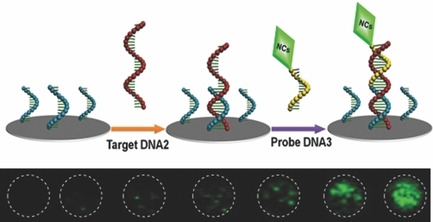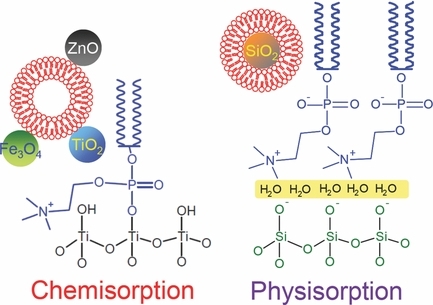Journal list menu
Export Citations
Download PDFs
Cover Picture
Tissue Engineering: Multiscale Patterning of a Biomimetic Scaffold Integrated with Composite MicrospheresMultiscale Patterning of a Biomimetic Scaffold Integrated with Composite MicrospheresMultiscale Patterning of a Biomimetic Scaffold Integrated with Composite Microspheres (Small 19/2014)
- Page: 3813
- First Published: 08 October 2014
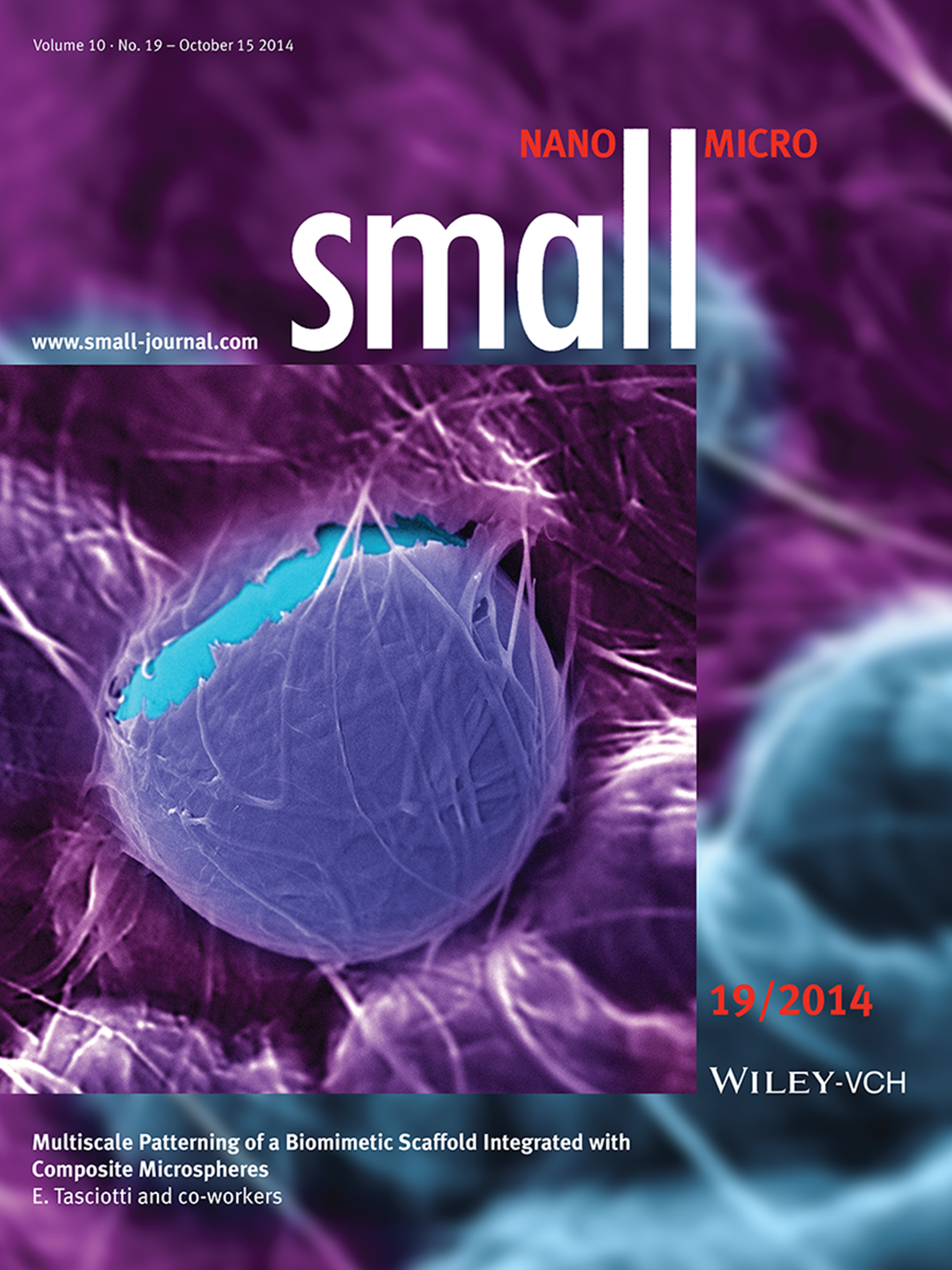
Ultrastructured fibrous collagen (pink) is functionalized with nanostructured composite microspheres (blue) by E. Tasciotti and co-workers to obtain 3D multi-layered scaffolds. As described on page 3943, the microspheres become part of the scaffold's intrinsic structure, ensuring the tight spatial and temporal confinement of delivered molecules. This scaffold allows the creation of compartimentalized 3D biomimetic environments.
Inside Front Cover
Photoluminescence: Dual Role of Blue Luminescent MoS2 Quantum Dots in Fluorescence Resonance Energy Transfer Phenomenon (Small 19/2014)
- Page: 3814
- First Published: 08 October 2014
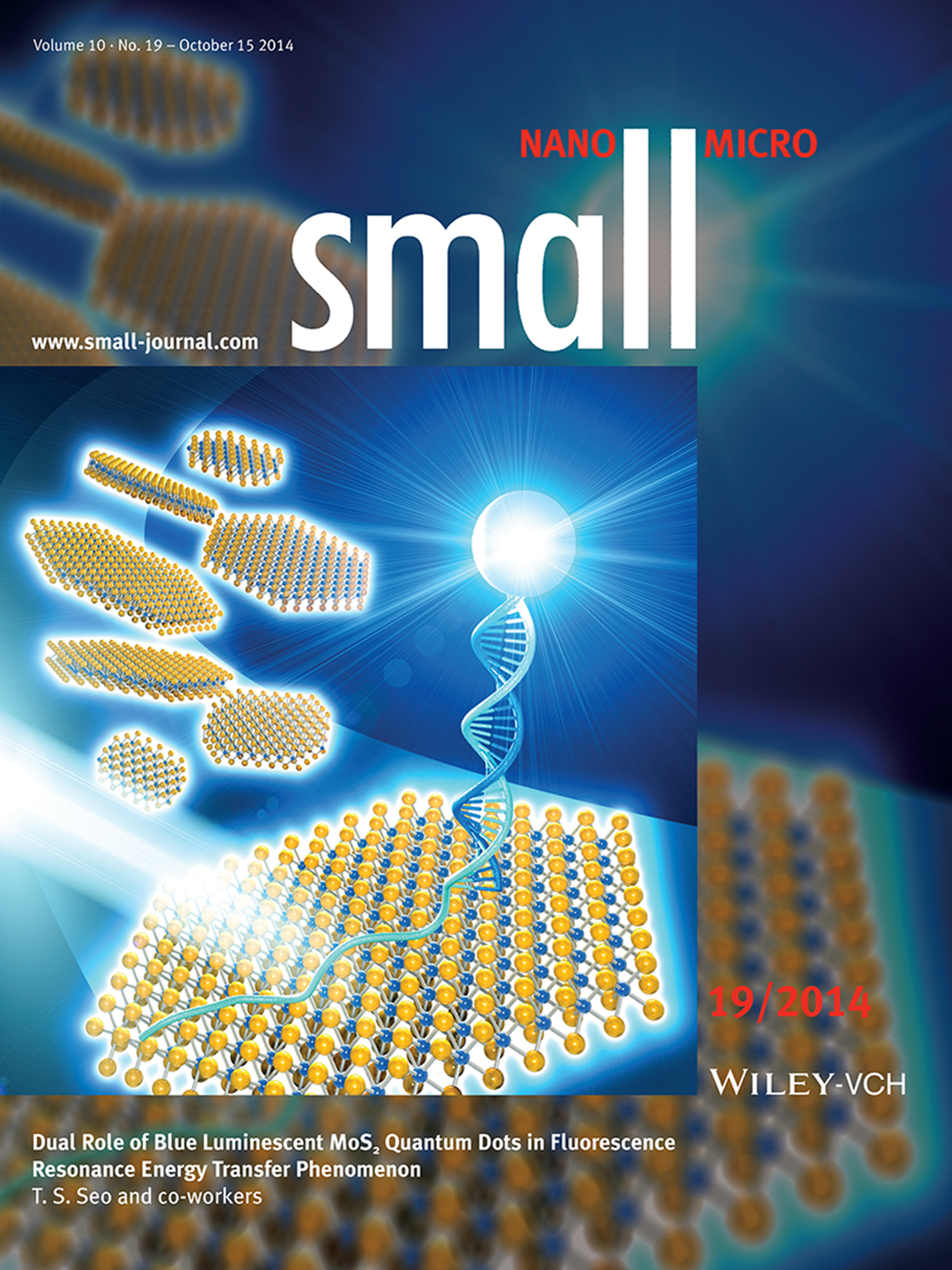
MoS2 nanosheets are explored by T. S. Seo and co-workers on page 3858. They are homogeneous in terms of the thickness (single layer) and dimension (10–20 nm in the lateral dimension) and with narrow size distribution reveal unique blue photoluminescence, and the luminescent MoS2 quantum dots can play a role as a donor or an acceptor in the fluorescence resonance energy transfer system of the Alexa Fluor 430-dsDNA-MoS2 conjugates.
Back Cover
Biosensors: Large-Scale Parallel Surface Functionalization of Goblet-type Whispering Gallery Mode Microcavity Arrays for Biosensing Applications (Small 19/2014)
- Page: 4032
- First Published: 08 October 2014
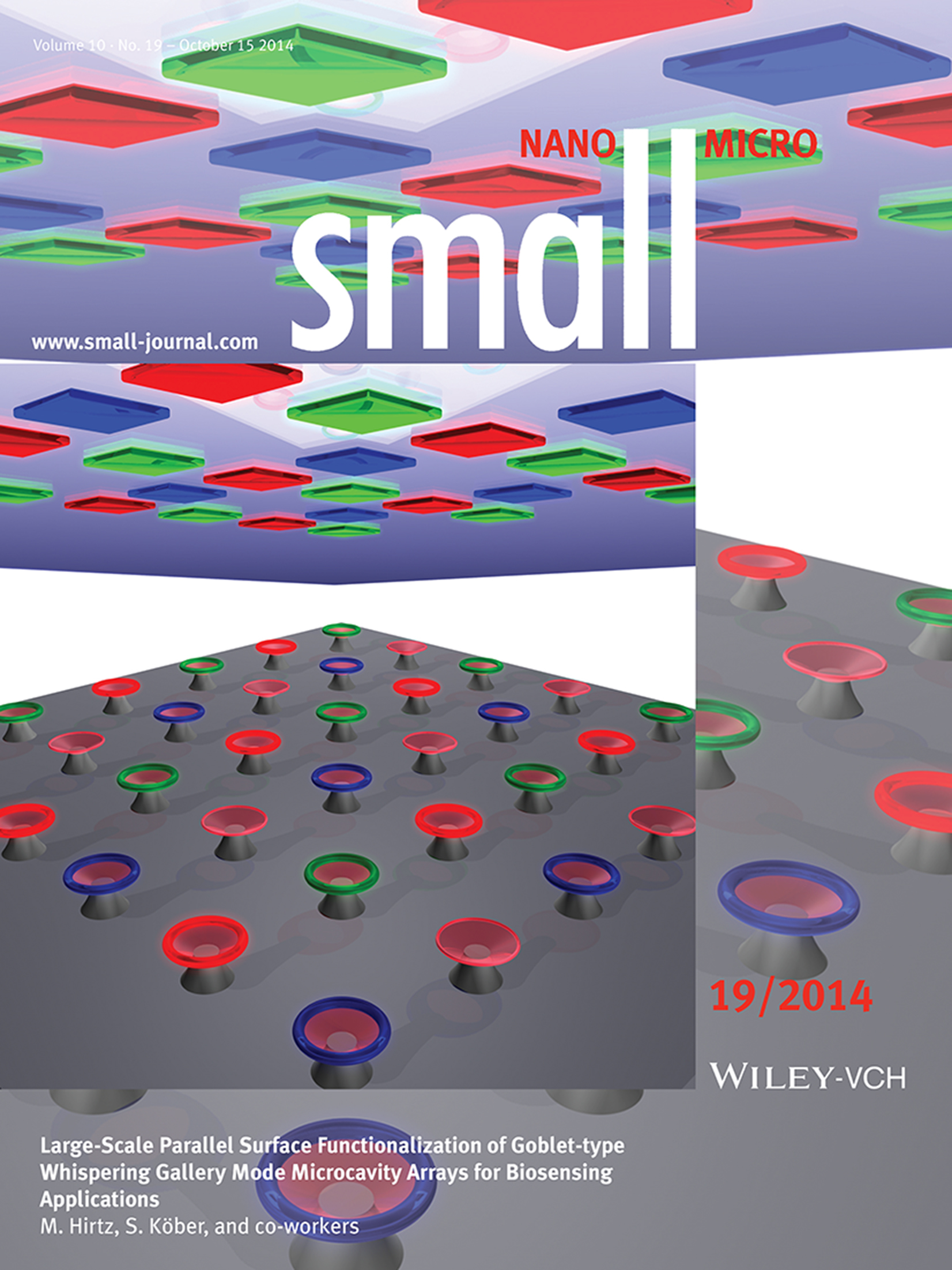
To enable competitive biomolecular screening of complex analytes, dense and selective surface functionalization of sensor transducers is imperative. On page 3863, M. Hirtz, S. Koeber, and co-workers report a novel technique allowing the large-scale deposition of functional inks onto individual chip-based sensors. Polymer pen lithography-prepared glass slides act as custom stamp pads to directly print biochemical acceptor molecules. The technique is applied to densely packaged arrays of whispering gallery mode microgoblet cavities, which are then shown to function as biosensors.
Masthead
Contents
Corrigendum
Magneto-Plasmonic Au-Fe Alloy Nanoparticles Designed for Multimodal SERS-MRI-CT Imaging
- Page: 3823
- First Published: 08 October 2014
Frontispiece
Molecular Imaging: Intrinsically Radiolabeled Nanoparticles: An Emerging Paradigm (Small 19/2014)
- Page: 3824
- First Published: 08 October 2014
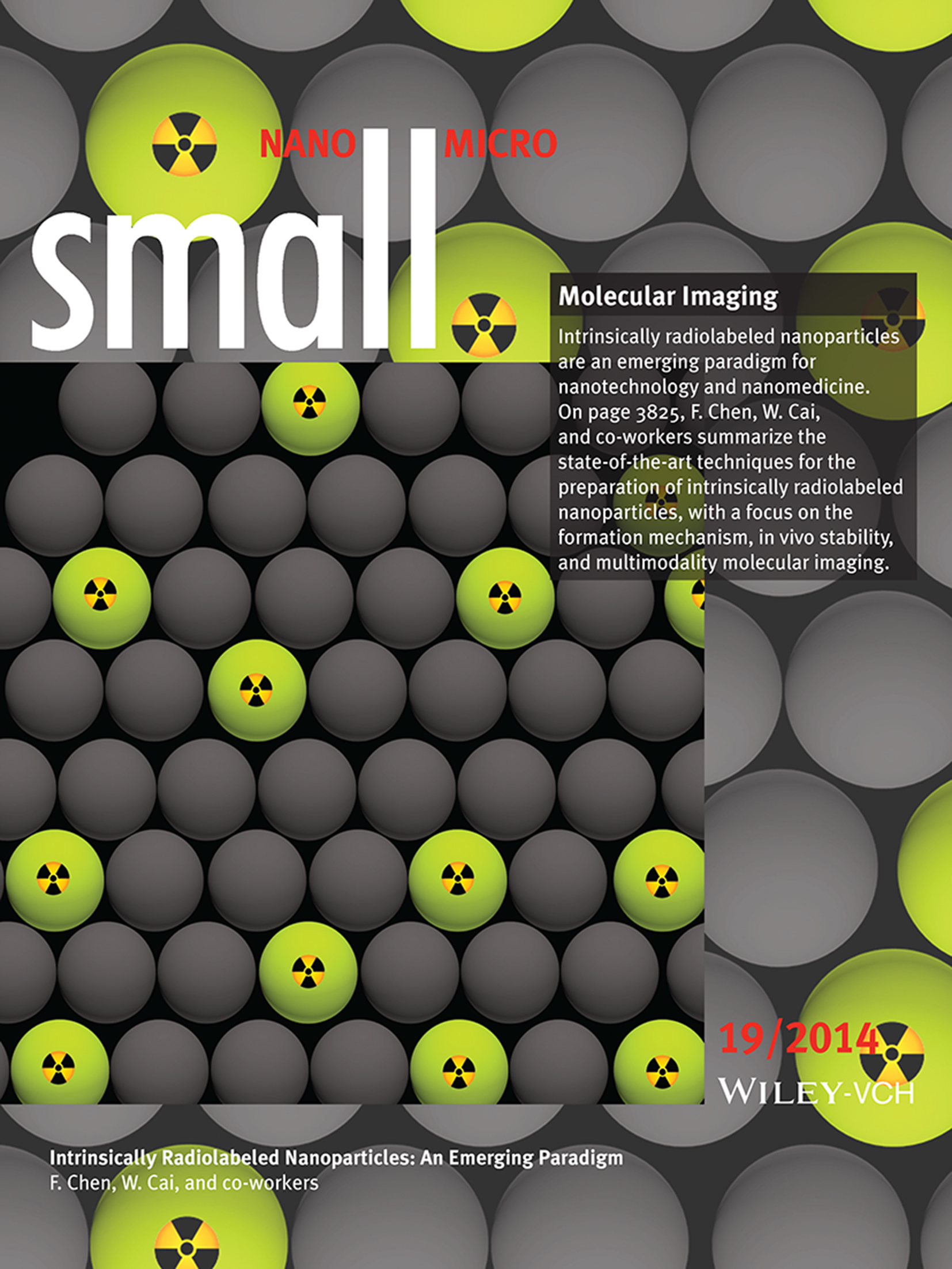
Intrinsically radiolabeled nanoparticles are an emerging paradigm for nanotechnology and nanomedicine. On page 3825, F. Chen, W. Cai, and co-workers summarize the state-of-the-art techniques for the preparation of intrinsically radiolabeled nanoparticles, with a focus on the formation mechanism, in vivo stability, and multimodality molecular imaging.
Concepts
Intrinsically Radiolabeled Nanoparticles: An Emerging Paradigm
- Pages: 3825-3830
- First Published: 30 June 2014
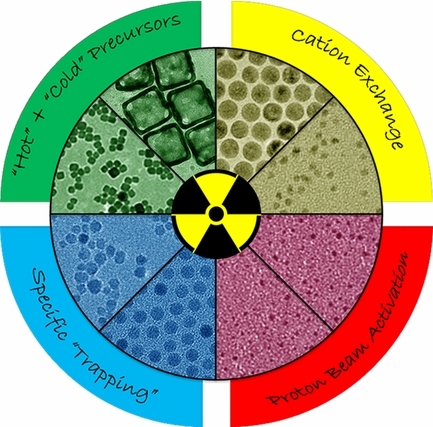
Concerns about the complexity of coordination chemistry, possible altering of carrier pharmacokinetics, and potential detachment of radioisotopes using traditional chelator-based radiochemistry, have driven the need for developing an improved technique for future radiolabeling. Here, a new concept of intrinsically radiolabeled nanoparticles which could be synthesized using four major strategies, without the assistance of traditional chelators, is introduced.
Reviews
Bio-Hybrid Cell-Based Actuators for Microsystems
- Pages: 3831-3851
- First Published: 04 June 2014
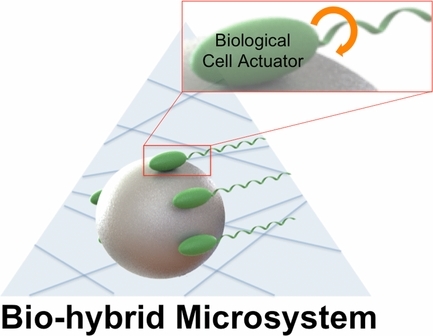
The use of live biological cells as bio-hybrid actuators has led to the development of novel microsystems. These systems utilize the sophisticated sensing and actuation capabilities of biological cells, enabling functional tasks to be performed at the microscale. Here, the recent advancements in the fabrication, design, and control of these bio-hybrid microsystems are reviewed.
Frontispiece
Nerve Cells: Enhanced Infrared Neural Stimulation using Localized Surface Plasmon Resonance of Gold Nanorods (Small 19/2014)
- Page: 3852
- First Published: 08 October 2014
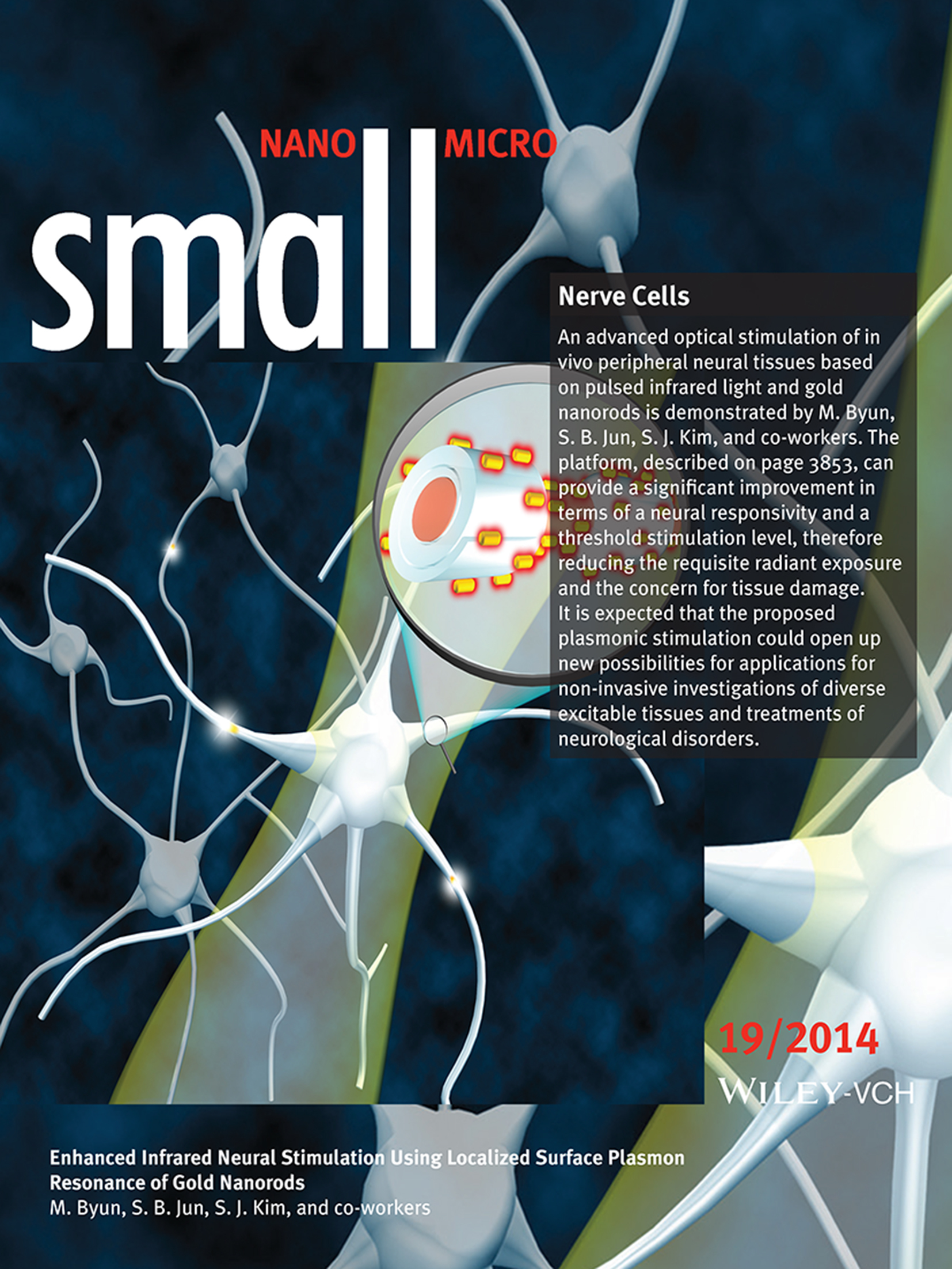
An advanced optical stimulation of in vivo peripheral neural tissues based on pulsed infrared light and gold nanorods is demonstrated by M. Byun, S. B. Jun, S. J. Kim, and co-workers. The platform, described on page 3853, can provide a significant improvement in terms of a neural responsivity and a threshold stimulation level, therefore reducing the requisite radiant exposure and the concern for tissue damage. It is expected that the proposed plasmonic stimulation could open up new possibilities for applications for non-invasive investigations of diverse excitable tissues and treatments of neurological disorders.
Communications
Enhanced Infrared Neural Stimulation using Localized Surface Plasmon Resonance of Gold Nanorods
- Pages: 3853-3857
- First Published: 27 June 2014
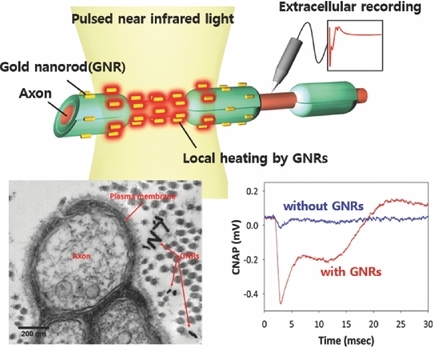
An advanced optical activation of neural tissues is demonstrated using pulsed infrared light and plasmonic gold nanorods. Photothermal effect localized in plasma membrane triggers action potentials of in vivo neural tissues. Compared with conventional infrared stimulation, the suggested method can increase a neural responsivity and lower a threshold stimulation level significantly, thereby reducing a requisite radiant exposure and the concern of tissue damage.
Dual Role of Blue Luminescent MoS2 Quantum Dots in Fluorescence Resonance Energy Transfer Phenomenon
- Pages: 3858-3862
- First Published: 27 June 2014

Homogeneous blue luminescent MoS2 quantum dots are fabricated by using a lithium intercalation method from MoS2 nanoparticles, and the unique blue photoluminescence property is utilized in the Alexa Fluor 430-dsDNA-MoS2 FRET system, demonstrating the dual function of MoS2 quantum dots as a donor and an acceptor.
Large-Scale Parallel Surface Functionalization of Goblet-type Whispering Gallery Mode Microcavity Arrays for Biosensing Applications
- Pages: 3863-3868
- First Published: 02 July 2014
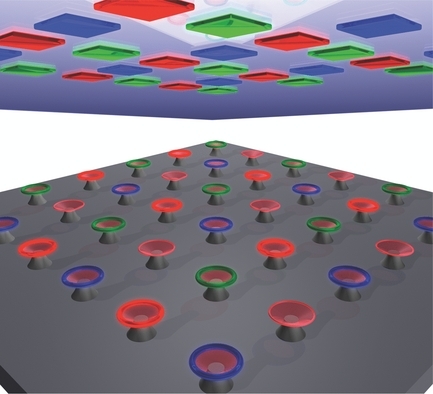
A novel surface functionalization technique is presented for large-scale selective molecule deposition onto whispering gallery mode microgoblet cavities. The parallel technique allows damage-free individual functionalization of the cavities, arranged on-chip in densely packaged arrays. As the stamp pad a glass slide is utilized, bearing phospholipids with different functional head groups. Coated microcavities are characterized and demonstrated as biosensors.
A Nano-Stripe Based Sensor for Temperature Measurement at the Submicrometer and Nano Scales
- Pages: 3869-3875
- First Published: 30 May 2014
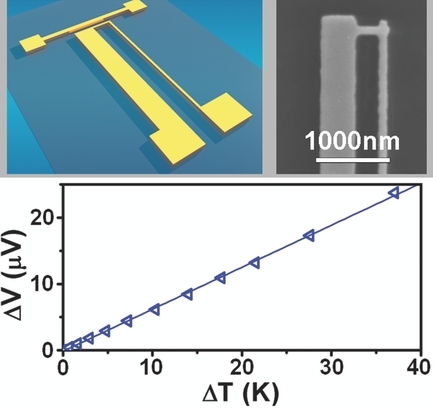
Submicrometer dual-stripe temperature sensors made from a single piece of metal thin film (e.g., Pd) are developed. With the narrowest sensor being 900 nm in width, they show sensitivity of 1–2 μV/K for the full range of 10–300 K. The results confirm the size effect in Seebeck coefficient previously observed in microstripe sensors of the same device configuration.
Self-Assembly of Collagen Building Blocks Guided by Electric Fields
- Pages: 3876-3879
- First Published: 10 June 2014
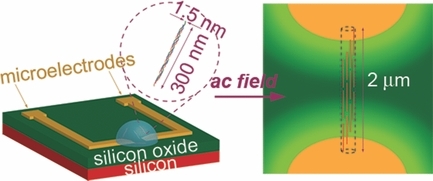
Show me the way: protein building blocks are programmed to assemble hierarchically and yield a defined fiber morphology of micrometric length and precise nanometric diameter. The key step of this method is to align the building blocks with an AC field prior to assembly. The resulting protein nanofibers are straightforwardly integrated with the circuitry for potential applications in bionanotechnology.
3D Networked Graphene-Ferromagnetic Hybrids for Fast Shape Memory Polymers with Enhanced Mechanical Stiffness and Thermal Conductivity
- Pages: 3880-3886
- First Published: 10 June 2014
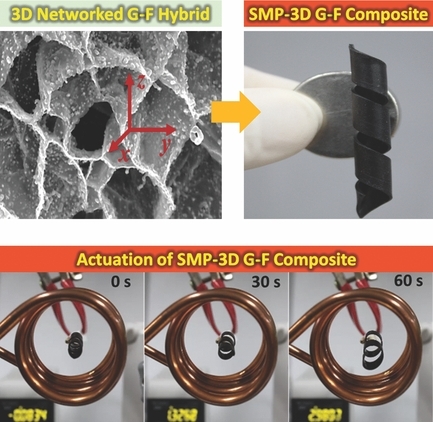
A novel 3D networked graphene-ferromagnetic hybrid can be easily fabricated using one-step microwave irradiation. By incorporating this hybrid material into shape memory polymers, the synergistic effects of fast speed and the enhancement of thermal conductivity and mechanical stiffness can be achieved. This can be broadly applicable to designing magneto-responsive shape memory polymers for multifunction applications.
Nature-Replicated Nano-in-Micro Structures for Triboelectric Energy Harvesting
- Pages: 3887-3894
- First Published: 10 June 2014
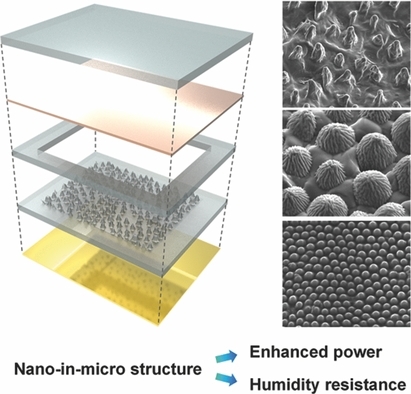
Triboelectric nanogenerators with nature-replicated interface structures are presented. Effective contact areas of the triboelectric surfaces are largely enhanced because of the densely packed nano-in-micro hierarchical structures in nature. The enlarged contact area causes stronger triboelectric charge density, which results in output power increment. The interface engineering also allows the improved humidity resistance, which is an important parameter for the stable energy harvesting.
Au2Sx/CdS Nanorods by Cation Exchange: Mechanistic Insights into the Competition Between Cation-Exchange and Metal Ion Reduction
- Pages: 3895-3900
- First Published: 02 June 2014
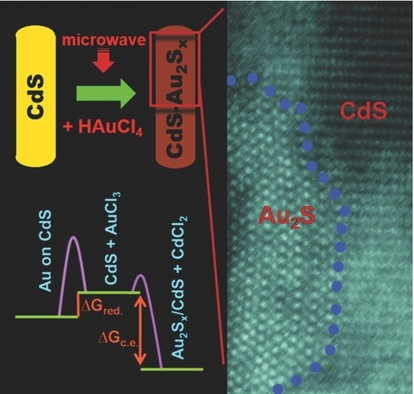
It is well known that metals with higher electron affinity like Au tend to undergo reduction rather than cation-exchange. It is experimentally shown that under certain conditions cation-exchange is dominant over reduction. Thermodynamic calculation further consolidates the understanding and paves the way for better predictability of cation-exchange/reduction reactions for other systems.
Cu2+ Ion Responsive Solvent-Free Quantum Dots
- Pages: 3901-3906
- First Published: 26 May 2014

Three quantum dots (QDs) nanofluids modified with different lengths of PEG chainsare synthesized, and the property-structure relationship of QDs nanofluids is established, to achieve QDs nanofluids with tunable fluidic or optical performance. Notably, the proposed QDs nanofluids demonstrate a selective response towards Cu2+-based on both fluorescence and contact angle.
Supramolecular Assembly of Macroscopic Building Blocks Through Self-Propelled Locomotion by Dissipating Chemical Energy
- Pages: 3907-3911
- First Published: 19 May 2014
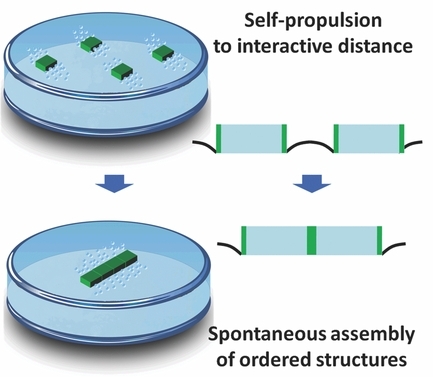
Chemical energy supplied by the catalytic decomposition of H2O2 is introduced into macroscopic building blocks, which self-propel, interact with each other, and finally assemble into ordered and advanced structures. The geometry is highly dependent on the way that the catalyst is loaded. The integration of catalyst and building block provides assembling component as well as its energy of motion.
Paper-Based DNA Detection Using Lanthanide-Doped LiYF4 Upconversion Nanocrystals As Bioprobe
- Pages: 3912-3917
- First Published: 16 May 2014
Direct Alignment and Patterning of Silver Nanowires by Electrohydrodynamic Jet Printing
- Pages: 3918-3922
- First Published: 13 June 2014
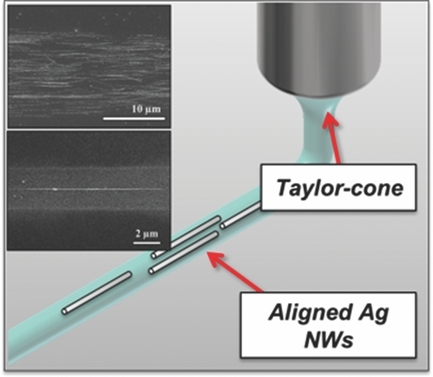
Highly aligned and patterned silver nanowires (Ag NWs) are investigated by using electrohydrodynamic (EHD) jet printing. Interaction between the flow field and the electric field as well as the mechanical stretching of the fiber jet can successfully align the Ag NWs inside the jet fiber. This technique can be applied in fabricating 1D nanostructures-based printed micro/nanoscale devices.
Assembly of Barcode-like Nucleic Acid Nanostructures
- Pages: 3923-3926
- First Published: 30 June 2014
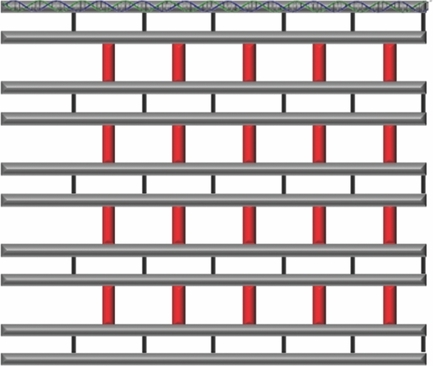
Barcode-like (BC) nanopatterns from programmed self-assembly of nucleic acids (DNA and RNA) are reported. BC nanostructures are generated by the introduction of open spaces at selected sites to an otherwise closely packed, plain, rectangle nucleic acid nanostructure. This strategy is applied to nanostructures assembled from both origami approach and single stranded tile approach.
Liposome Supported Metal Oxide Nanoparticles: Interaction Mechanism, Light Controlled Content Release, and Intracellular Delivery
- Pages: 3927-3931
- First Published: 26 May 2014
Frontispiece
Plasmonic Coupling: Wafer-Scale Double-Layer Stacked Au/Al2O3@Au Nanosphere Structure with Tunable Nanospacing for Surface-Enhanced Raman Scattering (Small 19/2014)
- Page: 3932
- First Published: 08 October 2014
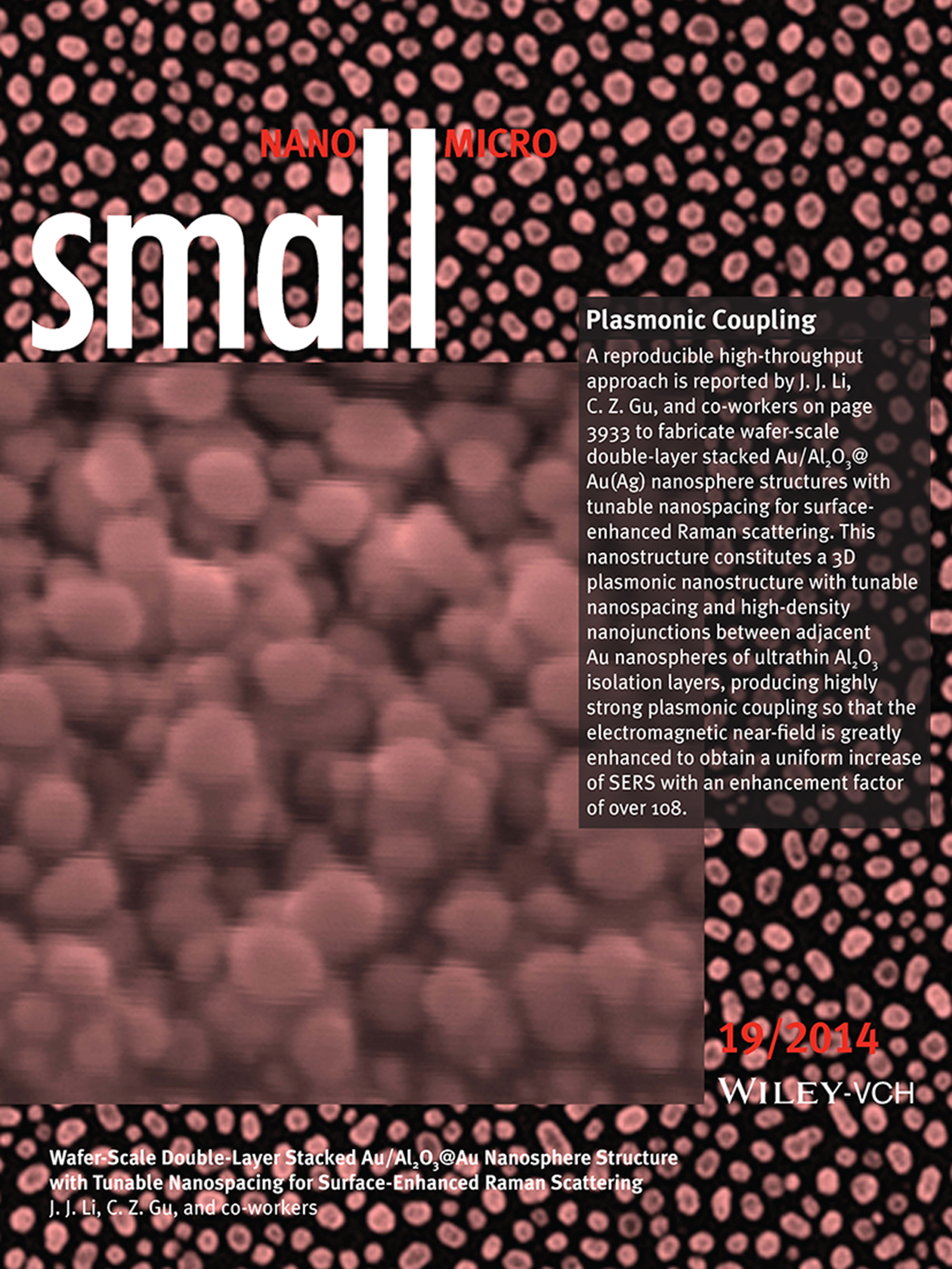
A reproducible high-throughput approach is reported by J. J. Li, C. Z. Gu, and co-workers on page 3933 to fabricate wafer-scale double-layer stacked Au/Al2O3@Au(Ag) nanosphere structures with tunable nanospacing for surface-enhanced Raman scattering. This nanostructure constitutes a 3D plasmonic nanostructure with tunable nanospacing and high-density nanojunctions between adjacent Au nanospheres of ultrathin Al2O3 isolation layers, producing highly strong plasmonic coupling so that the electromagnetic near-field is greatly enhanced to obtain a uniform increase of SERS with an enhancement factor of over 108.
Full Papers
Wafer-Scale Double-Layer Stacked Au/Al2O3@Au Nanosphere Structure with Tunable Nanospacing for Surface-Enhanced Raman Scattering
- Pages: 3933-3942
- First Published: 03 July 2014
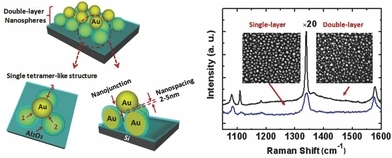
A double-layer stacked Au nanosphere structures with dense sub-5 nm nanospacing is designed to produce high density and high intensity “hot spots” effect. A reproducible high-throughput technique is shown to fabricate this plasmonic nanostructures, obtaining highly uniform increase of SERS with an enhancement factor of over 108 for ultrasensitive Raman detection, molecular electronics, and nanophotonics.
Multiscale Patterning of a Biomimetic Scaffold Integrated with Composite Microspheres
- Pages: 3943-3953
- First Published: 28 May 2014
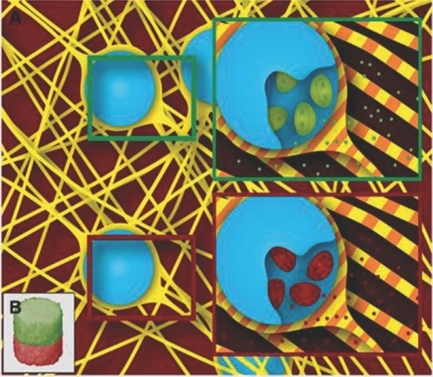
A novel multiscale approach for the spatiotemporal patterning of biomimetic scaffold is developed. Under controlled conditions, composite microspheres are coated with the type I collagen matrix of the scaffold, which simultaneously allows spatial confinement of the delivery system, and its payload, in different compartments of the scaffold, while adding a further level of control over the release kinetics.
A 3D In Vitro Cancer Model as a Platform for Nanoparticle Uptake and Imaging Investigations
- Pages: 3954-3961
- First Published: 02 July 2014
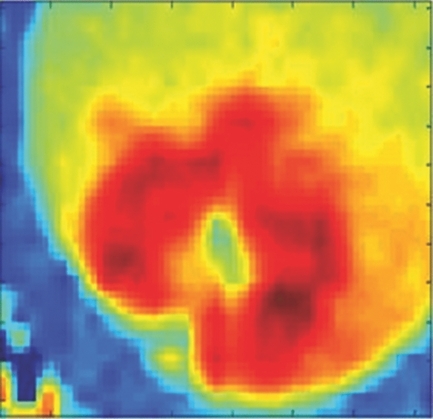
A novel 3D biomimetic tumour model and custom-made nanoparticle imager is presented as a platform for nanoparticle uptake studies. The model comprises a dense cancer mass with stroma, each with engineerable characteristics. Cancer versus stromal cellular uptake of gold nanoparticles within the model is quantified and 3D imaged, the delineated cancer mass emitting five times more than the surrounding stroma.
One-Step, Room-Temperature Synthesis of Glutathione-Capped Iron-Oxide Nanoparticles and their Application in In Vivo T1-Weighted Magnetic Resonance Imaging
- Pages: 3962-3969
- First Published: 09 July 2014
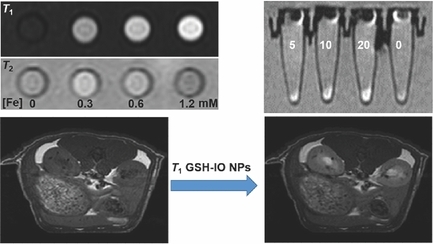
An unprecedented room-temperature, aqueous-phase synthesis of iron-oxide nanoparticles (IO NPs) capped with glutathione (GSH) is reported. The GSH-IO NPs can improve the signal intensity in T1-weighted magnetic resonance imaging (MRI). The NPs avoid ingestion by the reticuloendothelial system, and they successfully reveal the detailed anatomy and physiological functions in animal models. As a result, these NPs provide a new route towards high-performance, long-circulating MRI contrast agents with bio-targeting potential.
Plasmonic Enhancement in BiVO4 Photonic Crystals for Efficient Water Splitting
- Pages: 3970-3978
- First Published: 11 June 2014
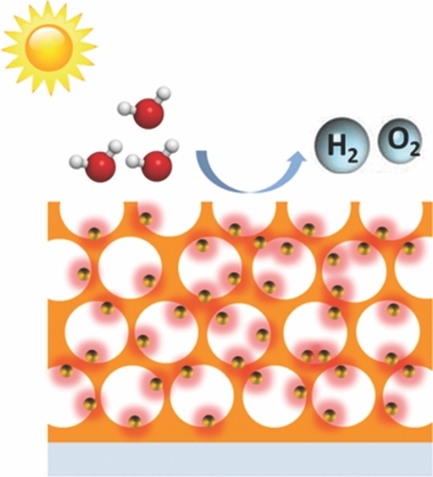
A photonic nano-architecture is designed to enhance solar water splitting efficiency by manipulating and confining light absorption. Coupling of an inverse opal photonic crystal and localized surface plasmons from Au nanoparticles is observed in this photonic architecture. Within the scaffold of an inverse opal photonic crystal, the surface plasmon resonance is significantly enhanced by the photonic Bragg resonance.
Microfluidic Molding of Photonic Microparticles with Engraved Elastomeric Membranes
- Pages: 3979-3985
- First Published: 20 June 2014
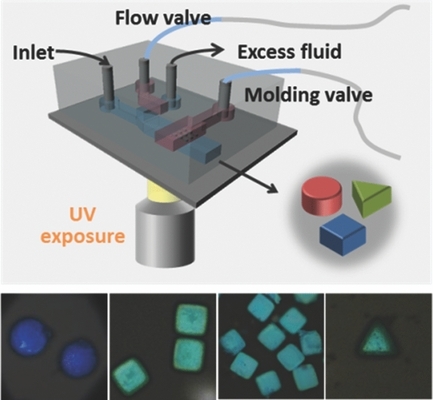
Photonic microparticles with diverse shapes are prepared by microfluidic molding approach. Double-layered microfluidic devices with engraved elastomeric membrane enable the robust production of microparticles through repeating a cycle of molding, photopolymerization, and release of microparticles. The microparticles can be designed to have periodic nanostructure by colloidal self-assembly and magnetic moment, thereby providing pronounced structural colors and magnetic functionality.
Inhibition of 3-D Tumor Spheroids by Timed-Released Hydrophilic and Hydrophobic Drugs from Multilayered Polymeric Microparticles
- Pages: 3986-3996
- First Published: 20 June 2014
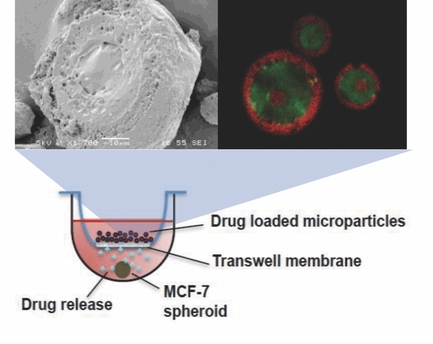
Dual-drug-loaded, multilayered polymeric microparticles fabricated through a one-step technique offer greater versatility in controlling drug release kinetics through the manipulation of structural configurations. Controlled and sustained co-delivery of multiple anticancer drugs from these multilayered microparticles significantly reduces MCF-7 3D spheroid growth rate, in comparison with single-drug-loaded particles. This rate-controlling particulate system creates new opportunities for combination chemotherapy.
Recycling Bacteria for the Synthesis of LiMPO4 (M = Fe, Mn) Nanostructures for High-Power Lithium Batteries
- Pages: 3997-4002
- First Published: 16 June 2014
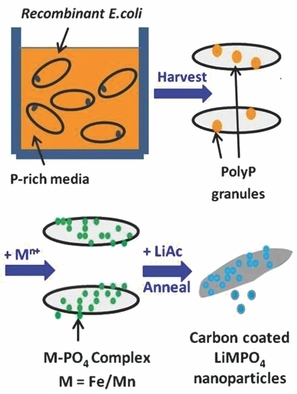
LiFePO4 and LiMnPO4 nanoparticles are synthesized using phosphorus harvested from wastewater via Escherichia coli bacteria. These particles are enveloped in a 3–5 nm thick carbon layer, generated through the decomposition of the organic matter from the bacterial cell cytoplasm. The carbon-coated LiFePO4 nanoparticles exhibit excellent stability and rate capability, ideal as cathodes for lithium-ion batteries.
High-Quality Monolayer Graphene Synthesis on Pd Foils via the Suppression of Multilayer Growth at Grain Boundaries
- Pages: 4003-4011
- First Published: 10 June 2014
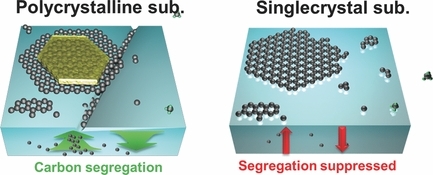
High-quality monolayer graphene on Pd substrates is synthesized using low-pressure chemical vapor deposition. The suppression of grain boundary segregation is made possible by pretreating the Pd foils with an annealing step. The quality of the graphene is evaluated using detailed scanning tunneling microscopy characterization and field-effect transistor (FET) measurements, revealing considerable room-temperature carrier mobility: 3650 cm2 V−1 s−1.
Competitive Reaction Pathway for Site-Selective Conjugation of Raman Dyes to Hotspots on Gold Nanorods for Greatly Enhanced SERS Performance
- Pages: 4012-4019
- First Published: 20 June 2014
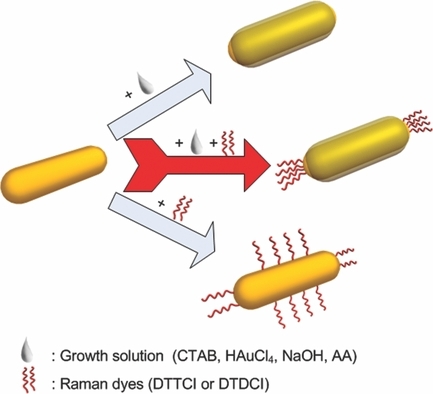
A competitive reaction between gold overgrowth and dye conjugation to gold nanorods is described. The preferentail gold overgrowth reaction on the nanorod side surface leads to dye conjugation only on the hotspot (end) of the gold nanorods. The dye-gold-nanorod conjugates produce much stronger SERS signals than the sample synthesized by a conventional conjugation reaction.
Fracture-Based Fabrication of Normally Closed, Adjustable, and Fully Reversible Microscale Fluidic Channels
- Pages: 4020-4029
- First Published: 18 June 2014
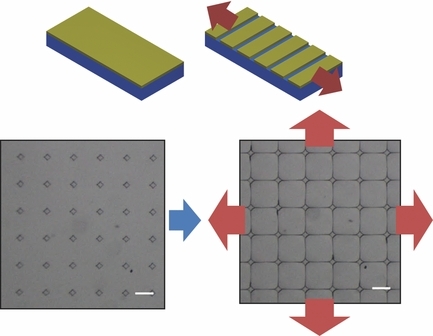
Multilayered materials are engineered such that applied tension generates micro scale cracks at pre-defined positions and with specified dimensions. These cracks can be used as normally closed and fully reversible microfluidic channels, and should be applicable in a variety of contexts. Here, the manipulation of chromatin released from single cells for subsequent epigenetic analysis is demonstrated.





